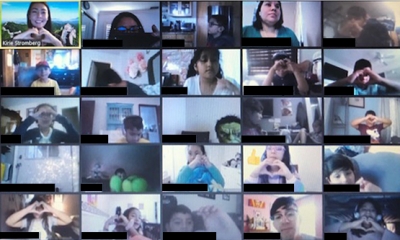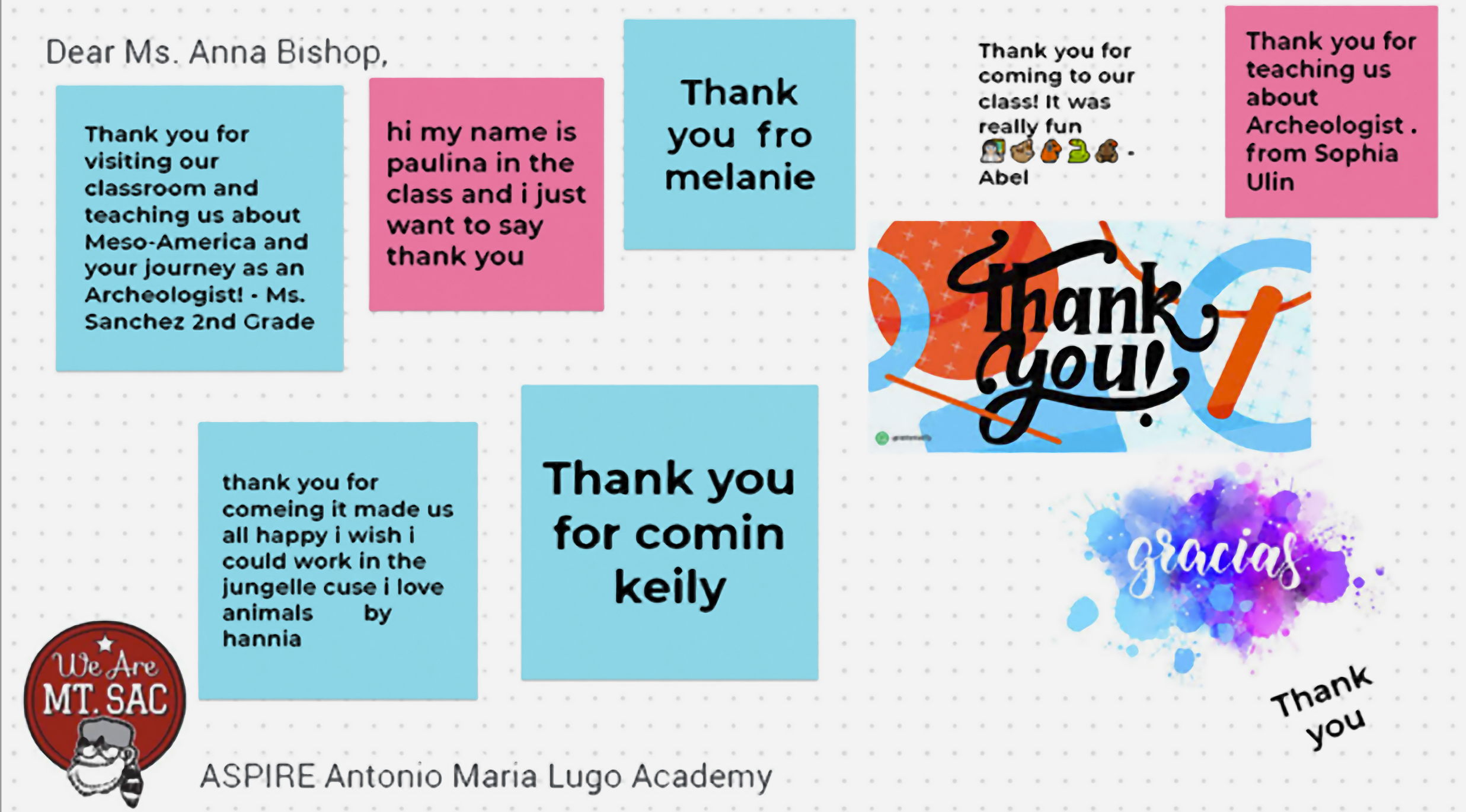“Ask an Archaeologist” Stimulates K-12 Curiosity

What do Percy Jackson, “garbology,” and the Terracotta Army have in common? They all stimulate young minds to think about archaeology and to “Ask an Archaeologist,” if given a chance.
That chance is being provided by a group of volunteer graduate students at the Cotsen Institute who offer virtual presentations in archaeology to K-12 students. The “Ask an Archaeologist” program was created by Camille Acosta, who describes herself as “passionate about educational outreach.” When her in-person efforts were shut down a year ago because of the pandemic, she decided to focus on creating an online program that would reach schools, many of which had limited resources.
Providing Learning Opportunities to Diverse Schools
This has resulted in schools throughout the greater L.A. area and beyond having the opportunity for a digital visit by an archaeologist from the Cotsen Institute who is able to tailor the presentation to the interests of each class. Word has even spread out-of-state, and volunteers have talked to classes in Indiana, Arizona, Virginia, and all the way to an international school in Guatemala, where the students were learning about the Maya.
Acosta explained that in March, 2020, the same week UCLA moved its instruction online, “I had been scheduled to visit a school in South L.A., where about 80% of the students are English language learners. For them, having an archaeologist come is really inspiring, and it is exciting for the kids to meet people from UCLA. When the in-person visit was canceled, I asked the teacher if she would like me to visit virtually. She absolutely did. I talked to them about an excavation that I work on, and I just answered their questions which ranged from ‘have you ever excavated a body?’ to ‘where does the dirt go?’
“They were really interested in Greek gods and goddesses because they had just read Percy Jackson, and the site that I excavated has many Greek sanctuaries dedicated to different gods,” Acosta continued. “They asked about what people give to the gods and how they interact with the gods. Then I asked them what they think of the gods. I lectured for about seven minutes, with lots of pictures. I just wanted to show them what archaeologists do, but mostly to let them talk.“
Remote Presentations Simple to Put Together and Have Impact
“Remote presentations are simple to put together and can have a lot of impact,” according to Acosta. "So I thought this would be a great way to go outside the normal range of schools with which we work. Plus it gives the teachers a break: just an hour of letting someone else engage with the kids about something they might find exciting. And I had been trying to think of an outreach program that can outlast me when I graduate.
“I think it is really important to be able to explain your work to the general public and to young students. This is how you inspire the next generation to do archaeology. Sometimes it is easier to just stay in an academic bubble and not think about the impact of your work on the world. For my own research, I work on migration, and many of these kids come from immigrant families. I try to explain that it is really important to study migration in ancient Greece and why it is relevant today,” she continued.
“Some schools are including these lectures in social studies, history or the humanities. But archaeology is also relevant to the STEM (science-technology-engineering-math) curriculum, as well. Many of our researchers use scientific techniques in their work, from determining the age of a site to preserving artifacts in a museum, and they can explore these techniques with students in STEM classes,” Acosta explained.
Volunteers Paired by Subject with Teachers
“For ‘Ask an Archaeologist,’ all I really did was recruit volunteers, manage it, and pair people with teachers.” Teachers who request a visit by an archaeologist are paired with students in two different ways, Acosta said.
Teachers have responded very positively to the presentations. Local teacher Angel Lassalle had Matei Tichindelean, another graduate student at the Cotsen Institute, speak to four sixth-grade classes in two days. Lassalle said he had been looking online to see if there was a way his kids could actually experience meeting an archaeologist in the classroom because he was teaching them about Egyptian archaeology at the time. He found the “Ask An Archaeologist” site, contacted them, and was put together with Tichindelean, whose expertise is Egyptology. Tichindelean, who had talked with Lassalle before the presentations, showed artifacts and spoke about archaeology and how a student could become an archaeologist. Lassalle added that “we want them to be able to pursue these careers that they might not really know about.”
Teachers Grateful for Something New and Interesting for Students
One teacher sent a note saying “Thank you so much for spending your time teaching my students about archaeology. They had a really great time. I am glad they have a chance to experience different careers and hear more about what you’re learning. The presentation was wonderful, and they still had questions after you left.”
Acosta pointed out that some of the teachers are just happy that the students have something different to do. Many teachers will create a reading assignment for the students before the presentation, urging them to prepare questions for the archaeologist based on the reading. “We try to line up with whatever region or theme they are studying,” Acosta said. For example, there was a second grade class that was learning about folk tales. So graduate students Kirie Stromberg talked to them about the Terracotta Army and Chinese stories, and Kellie Roddy talked about Mexican history. We are trying to find cultural touchstones and work them into archaeology,” she explained. “The most fun is just letting the kids loose to see what they come up with.”
Fortunately, there is a great interest in volunteering for the program, according to Acosta. “At the Cotsen Institute, there are a lot of people who want to do this. They understand its value. But there’s also a sense of appreciation for what the teachers are doing and wanting to help in any way we can. And it is really fun. It’s a nice change of pace for an hour. It doesn’t take a lot of effort to make a big impact,” she concluded.
Program Value Also Recognized by Volunteers
Egyptologist Tichindelean acknowledged Acosta for putting the program together and, as a former middle school teacher himself, recognized its value immediately. “A lot of the kids like Egypt because of the mummies and popular media. They have wonderful curiosity and ask really interesting questions, like ‘how does the brain come out of the mummy’s head?’ But they are also interested in how people lived. So I explained to them how we learn about the way they lived by looking at objects or depictions. And I tried to get across to them that it was not entirely different from how we live now. Having taught sixth grade myself, I knew not to just make a presentation, but to ask questions. I would put up a picture and ask them what they thought it was. There were even a few who said they wanted to become archaeologists. It is our job as archaeologists to relay the information we have to a wider public audience. And the best way to do it is to talk to kids,” he added.
Celine Wachsmuth, a graduate student in conservation at the Cotsen Institute, also had previous experience speaking in K-I2 classrooms when she was studying in Philadelphia, so she thought this was a great opportunity to expand on her earlier efforts. In her presentation, she talked about how she got into the field, what her personal journey was like, and explained what a conservator was. “The easiest way to explain it is to say we are like doctors. We take care of things when they come in. We try to figure out the best way to make sure they are OK. But we also try to understand where the object comes from as part of a larger story,” she said.
Explaining How Conservators Work with Archaeologists
“I actually got a question from a child who asked about who takes care of objects in the field. So I ended up talking about the crossovers between archaeology and conservation and how archaeologists should always be working with a conservator. Another student wanted to know what happens if you do something wrong. I explained that you stop and evaluate to make sure that whatever you are doing doesn’t happen again. And you record everything so that everyone can learn from these mistakes,” Wachsmuth said.
Other experiences by presenters included asking students to share objects that are valuable to them, an exercise that the students loved. Another volunteer did a quick “garbology” activity where “we picked items from the trash and talked about what you can learn from them.” One teacher even requested that the archaeologist make a presentation about housing in the ancient world and how it connected to climate and geography.
A thank-you note from a teacher summed up the value to the schools of the “Ask An Archaeologist” program. Her note read: “Thanks so much! The kids really enjoyed it and loved learning with you. As a teacher, I love the ‘Ask an Archaeologist’ program your department has. It’s a great way to bring in experts and make the learning more hands-on and relevant.”

Published on March 23, 2021.


